|
 |

by Hib Halverson
Page2 |
|
The History of Corvette Electronic Ride Control Systems
A ride-adaptive shock absorber system has been a Corvette
option since 1989. "Ride-adaptive" means the shocks adapt their damping to
the ride dynamics present as the vehicle moves. Corvette’s ride-adaptive
systems have always been computer-controlled with the driver having some
input to the strategy the computer uses to set the damping.
The first of these systems, "Selective Ride Control" (SRC)
was developed by Bilstein for the 1990 ZR-1. As RPO FX3, it was optional from
1989 to ’95 on all C4s but standard on ZR-1s. SRC had a wide range of damping
available between its softest and firmest setting. It changed its damping
according to vehicle speed. The faster the car went, the stiffer the shocks got.
|
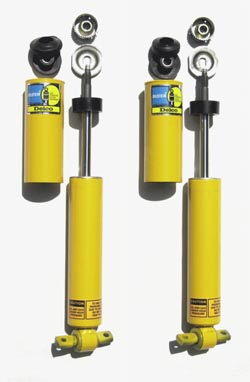
|
|
Into the historical archives for this one. This is a set of front shocks
from a C4 equipped with SRC. Image: author |
|
|
While it’s bandwidth was wide, SRC could not adjust damping according to
ride movement because its response time was quite slow, about 180
milliseconds (mSec) or about a fifth of a second. In 1992, hardware
improvements and software changes cut that in half, but still, by
today’s standards, you could have benchmarked SRC’s speed with a sun
dial.
The driver had input to this system via a three-position
switch that altered bandwidth and moved the damping range up or down the vehicle
speed scale. The "Tour" position had six steps of damping and remained at the
system’s least aggressive valving until 50 mph. From there, damping increased in
25 mph increments until 100 mph where the highest step in that range used about
50% of the system’s available damping authority. "Sport" had five ranges of
damping but its lowest step (0-25 mph) had the same damping that Tour had at 100
mph. Sport’s highest step used about 80% of the system’s available damping
authority. The "Performance" range (marked "Perf" on the switch) only used four
steps and its lowest step was more aggressive than the highest step in Tour. The
Perf range was also the only one where the system’s full damping authority was
used and that came at speeds of above 78 mph.
|
|
SRC was leading-edge stuff for a high-volume sports car at the end of the 1980s.
The system’s control software was the most sophisticated used in any electronic
ride control system of the period. Even at the end of its production in model
year 1995 (MY95), it was still a very useful system
|
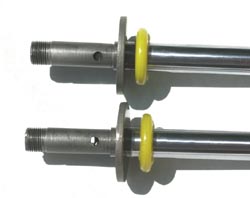 |
|
The heart of an SRC shock was a sleeve-valve bypass that allowed shock
oil to bypass the valves in the piston during damping. The amount the
bypass was open determined the magnitude of the damping. Top shows the
valve closed. Bottom shows it open. Image: author. |
|
|
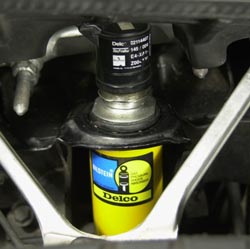 |
|
Shown here on a 1995 ZR-1, each SRC shock had an "actuator"
on the top that turned the sleeve valve. The amount the actuator turned the
valve shaft was determined by a signal generated by the SRC controller in a
storage well behind the driver seat. Image: author.
|
|
In 1996, for the final C4 model year, RPO F45, "Selective
Real-Time Damping" (RTD) was released. Developed for GM by Delphi Corporation,
RTD used data from suspension motion sensors to set the damping level. The
system’s response was "near real time" To process data and accomplish a damping
change inside the shocks took about 35-mSec. RTD marked the first time any
production sports car had a shock absorber system which "read" the road and used
that data to change damping.
MY96 RTD’s weakness was only two levels of damping: "soft"
and "firm". This system was a bit limited in bandwidth but was "pulled forward",
as Dave Hill likes to say, from the C5 development to get a "road-reading"
damper system on Corvette and generate some additional technical interest in C4
during its final year.
Some critics of the system, this writer included, believe
that, under marketing pressure to get such a system in production, GM
compromised on damping bandwidth because the technology necessary to have a
wider-bandwidth RTD system was not quite mature in the precision and speed with
which shock adjustments had to be accomplished.
This bi-state system’s lower level of damping provided
outstanding ride quality but the upper level ended-up only as aggressive as the
system’s limited bandwidth would allow. This amounted to "a little less soft",
and more typical of a base C4’s fixed valve shocks, rather than truly "firm"
damping appropriate for performance driving. The selector-switch carried over
from SRC but it’s functions were different. "Tour" enabled mostly soft damping.
"Sport" had damping mostly firm. "Performance" locked the system in firm.
C5 arrived in 1997 with continuously-variable RTD having
additional bandwidth through improvements in accuracy and speed of valve
adjustment. System response quickened to about 22-mSec. "CVRTD" had a more
powerful controller but used the same ride sensors and selector switch. While it
was another step forward, those who’ve read my articles about Corvette
suspensions in the past know I was not a fan of this system, either, because I
felt it did not contributed enough value to the car’s handling.
"MR is a lot quicker than CVRTD,"
Mike Neal tells the C5 Registry web site, "and that
was a fast system by the world standard. Amongst those doin’
electronically-adjustable suspensions, the Delphi CVRTD system was as fast, if
not way faster than others and MR is even faster than that."
While I was not a CVRTD supporter, the fact remains that Neal
is right. PR guys at European and Asian car companies can spin all they want,
but their chassis engineers can only wish they had the ride control Delphi sells
to GM in the various RTD systems currently on Cadillacs, some trucks and
Corvette up to MY02.
"When we did CVRTD, the easy part,"
Mile Neal continued,
"was damping body motion because it is slow, in the
one-to-two hertz range. The hard part was the wheel control stuff: chatter
bumps, impacts, in the 12-15Hz range. How do you get from being on a smooth
road, where you had low activity and all of a sudden–ka-boom!– you have a big
impact?
"Can you bring all the forces to bear quick enough to damp
the suspension in a way that isn’t harsh and brings plushness to the feel of the
event? That was a big challenge with CVRTD but MR is fast enough to be able to
do that."
With SRC and RTD, damping was hydro-mechanical. Shock oil was
forced through small orifices, or "valves," by movement of the shock piston and
rod in the oil-filled shock body. The valves’ resistance to oil flow provided
the damping. With SRC, a sleeve valve "bypass", concentric with the shock piston
rod and adjusted by an electric actuator, provided the change in damping. With
RTD, it was a bi-state valve or continuously variable pressure control actuator
on the side of the shock.
A traditional shock absorber doesn’t have just one valve. It
has many, all with different opening, closing and flow characteristics. Today’s
conventional shock absorbers are devilishly complex devices aimed at that
elusive damping compromise between performance handing and pleasing ride. While
they can do one or the other very well, even the best hydraulic shocks are only
adequate in how they address that compromise.
All ride-adaptive systems using adjustable valves have
limited bandwidth because of the slowness with which they change states along
with the slow response of the other, fixed-orifice valves. Darin Dellinger is a
Delphi engineer who’s worked on Corvette ride control systems for a number of
years. Emphasizing this slowness, he told us, "One of the challenges we had
to overcome with previous hardware related to valving. Damper valving is a
hindrance. Valving, in itself, has response time. So there’s slowness just in
the way those valves crack open or closed. The MR damper, because it doesn’t
have valving, opens up a whole bunch of opportunities we didn’t have before."
Eliminating these problems in one fell-swoop is RPO F55,
Magnetic Selective Ride Control. Under development by Team Corvette and Delphi
since 1996, MR has taken a long time to come to fruition because of the
engineering and development challenges in making it perform well. Dave Caldwell,
GM’s spokesperson for all things engineering-related on Corvette, told the C5
Registry web site, "Dave Hill views this (MR) as a ‘holy grail’ kind
of a thing that people have been trying to do for 20 years or more. We were
never sure when it was gonna get in the program, but we knew it would get in
when it was ready."
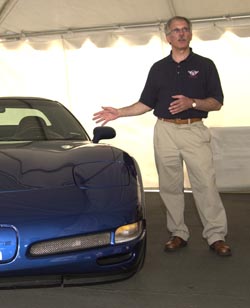 |
|
At a briefing in California in the spring of 2001 which introduced the
‘02 Z06 to the press, Dave Hill hinted at some C6 technology that would
come early to C5. Now we know this was MR. Image: author. |
|
Hill had been hinting since early-‘01 about, "...an aspect
of C6 technology we are trying to pull ahead into C5." MR was that
technology. MagneRide debuted in mid-’02 on the Cadillac STS. The system was
altered slightly then put on Corvette for MY03. It is optional on all coupes and
convertibles, standard on any car with the 50th Anniversary package but not
available in combination with Z51 or on Z06es.
After 2003, use of MagneRide on GM vehicles will continue to
increase. It will be standard on the ‘04 Cadillac XLR and optional on the ‘04
Cadillac SLX, a new, medium sized, rear-drive SUV.
MSRC is superior to other variable damping systems because 1)
it can apply almost twice the damping force and 2) has a quicker average
response time, about 10-mSec. GM claims MR is "five times faster" than RTD. We
researched that number and believe it was derived by comparing the slowest
expected RTD response (30-mSec.) with the quickest expected MR response.
(6-mSec.) In reality, depending on the damping situation, MR’s response time
ranges from about "the same as" to "as much as five times quicker than" ’97-’02
RTD but, on average, responds twice as quick.
|
|
Star Wars Secret Sauce
There’s no oil in a MR shock. It’s replaced by magnetorheological (say "mag-knee-toe-ree-oh-lodge-i-cal") fluid. "MRF" is manufactured by Lord Corporation of Cary, North Carolina and branded "Rheonetic Fluid".
MRF is a staggeringly complex, synthetic-hydrocarbon-based liquid having somewhere between 20% and 40% (by volume) carbonyl iron particles (CIP) in suspension. CIP are made using the "carbonyl decomposition process", developed by BASF in the 1930s. Iron pentacarbonyl is thermally decomposed, during which particles form and develop a shell structure. The result is microscopic, iron spheres having traces of carbon, oxygen and nitrogen in their shells. During this process, decomposition conditions determine the properties of CIP, including a key factor in MRF: "particle size distribution," which is the various sizes of particles, on a percentage basis, making up a volume of CIP. The particles’ high purity, typically 97.8-99.5% iron, offers excellent electromagnetic properties.
|
|
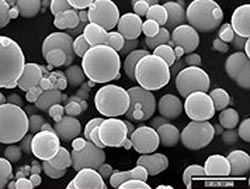
|
|
A scanning electron microscope image of carbonyl iron powder similar to
that used in the Corvette’s MRF. The sizes vary from about four to about 22 microns. Image: BASF |
|
|
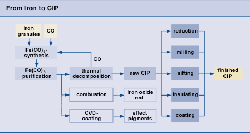 |
|
It takes
a complex procedure and a huge manufacturing operation to make CIP
suitable for use in MRF. This chart details the chemical and mechanical
processes at work during decomposition. Image: BASF (Click Image for
Larger View) |
|
CIP are a versatile substance. Not only are they a component of MRF, but they are the basis of products as varied as LS1/LS6 connecting rods and the iron "fortifiers" in food and nutritional products. Pour CIP in a mold, sinter, forge, then machine, and you have a LS1 rod. Crush some Total breakfast cereal, then run a magnet through it and you come-up with CIP.
There are few manufacturers of carbonyl iron particles and even fewer make CIP suitable for MRFs. BASF is the only one we could find that sells a product intended for magnetorheological fluids. BASF’s Dr. Al Friederang told us via email that one grade,
|
"...‘Carbonyl Iron Powder CR’ is specifically designed to meet the requirements of the magnetorheological fluid technology in automotive applications such as shock absorbers."
Asked for more information about Grade CR, Dr. Friederang was less accommodating, however, the good Doctor hinted that CR was similar to another BASF product, CM. According to BASF’s web site, Grade CM CIP vary in diameter from four to 22 microns with at least 50% of the particle distribution being seven microns in diameter. A micron is one millionth of a meter or 39 millionths of an inch (.000039-in.) so, we’re talking way small particles.
Adding to this frustrating lack of information, Lord
Corporation, also, declined to provide specifics about Rheonetic Fluid citing
the proprietary nature of the product. It is possible Lord does not use BASF raw
materials but, whatever the source of its CIP; we think it’s at least similar to
BASF’s grades CR or CM.
Before the particles are added to the fluid carrier, they
look and feel like black flour. Once MRF is formulated, it looks and feels like
dirty engine oil. The key property of this Star Wars witch’s brew is that its
flow characteristics (or "rheology") change when it’s subjected to a
direct-current, magnetic field. The CIP are attracted to each other and the
magnet’s poles, orienting themselves in a sort of fibrous matrix that changes
the fluid’s yield stress. This effect is proportional to the amount of CIP
present and the strength of the field. A little magnetism and MRF is like thick
oil. A little more and it’s like heavy gear lube. When the magnetic field is at
its strongest, the fluid is about like a grease. There are other applications of
magnetorheological fluid where on-state consistency is that of tar, rubber or
plastic.
|
|